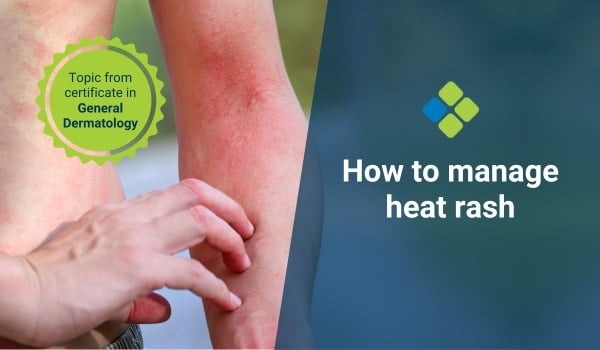How to manage heat rash
Read more about heat rash and its management in primary care, including assessment, diagnosis, and treatment.

HealthCert Education
Primary care doctors are the first line of defense for patients seeking relief from various skin conditions. Heat rash is no exception. The condition (also known as prickly heat or miliaria) is a common problem, especially during hot and humid weather. With proper additional training in general dermatology, GPs can effectively manage most cases of heat rash in their practice.
What is heat rash?
Heat rash occurs when sweat gets trapped in the sweat ducts. This leads to inflammation and the appearance of tiny red bumps on the skin (miliaria rubra). The areas of the skin that are usually affected are the ones where skin-to-skin contact occurs or where clothing causes friction. This usually includes:
- Neck,
- Armpits,
- Groin, and
- Areas covered by tight clothing
Assessing and diagnosing heat rash
When a patient presents with symptoms like redness, itching, and small bumps on the skin, a GP can consider the possibility of heat rash.
For proper assessment, it is vital to take detailed history, including:
- Recent exposure to hot and humid environments,
- Wearing tight clothing, and
- Excessive sweating.
Physical examination usually reveals small, red papules or vesicles in the affected areas.
Treating heat rash
The primary goal of heat rash treatment is to relieve symptoms and prevent further irritation. Here are some simple and effective strategies:
- Advise patients to stay in air-conditioned environments or use fans to help reduce sweating and keep the skin cool and dry. Wearing loose-fitting, breathable clothing made of cotton can also promote air circulation and prevent further irritation.
- Suggest gentle cleansing with mild soap and water to remove sweat and debris from the affected areas. It is also vital to avoid harsh soaps or scrubbing, as they can worsen irritation.
- Over-the-counter topical treatments, such as calamine lotion or hydrocortisone cream can help soothe itching and reduce inflammation. Emollient creams or ointments containing ingredients like colloidal oatmeal can also provide relief and promote skin healing.
- Encourage patients to avoid activities that may exacerbate heat rash, such as excessive sweating, prolonged sun exposure, or wearing tight clothing.
- Applying cool, damp cloths to the affected areas for 10-15 minutes several times a day can help alleviate itching and discomfort.
Most cases of heat rash resolve with self-care measures within a few days to a week. However, GPs should advise patients to follow up if symptoms persist or worsen despite treatment.
Referral to a dermatologist may be necessary for severe or recurrent cases that require further evaluation and management.
Managing heat rash in primary care is possible with simple and effective strategies aimed at relieving symptoms and preventing further irritation. By understanding the basics of heat rash and implementing practical treatment approaches, GPs can provide valuable support to patients seeking relief from this common skin condition.
– Dr Rosmy De Barros
For further information on this topic, you may be interested to learn more about the HealthCert online Professional Diploma program in General Dermatology.
Engaging with this blog can help meet your annual
|

How to claim your CPD hoursIf you consume educational webinars, podcasts, articles, or research on this blog, you can Quick Log CPD hours with the RACGP via the usual self-submission process. You will be asked to reflect on what you have learned, and you will require supporting evidence such as a screenshot.Download the RACGP’s guide to self-recording your CPD here. |
Read another article like this one: How to manage cold sores
References:
[1] Guerra KC, Toncar A, Krishnamurthy K. Miliaria. [Updated 2023 Aug 8]. In: StatPearls [Internet]. Treasure Island (FL): StatPearls Publishing; 2024 Jan-. Available from: https://www.ncbi.nlm.nih.gov/books/NBK537176/
[2] Pandolf KB, Griffin TB, Munro EH, Goldman RF. Heat intolerance as a function of percent of body surface involved with miliaria rubra. Am J Physiol. 1980;239(3):R233-R240. doi:10.1152/ajpregu.1980.239.3.R233
[3] Donoghue AM, Sinclair MJ. Miliaria rubra of the lower limbs in underground miners. Occup Med (Lond). 2000;50(6):430-433. doi:10.1093/occmed/50.6.430
[4] FORBES MA Jr, KING WC. Neomycin lotion in the treatment of miliaria rubra (prickly heat). Tex State J Med. 1956;52(6):342-343.

 1800 867 1390
1800 867 1390


